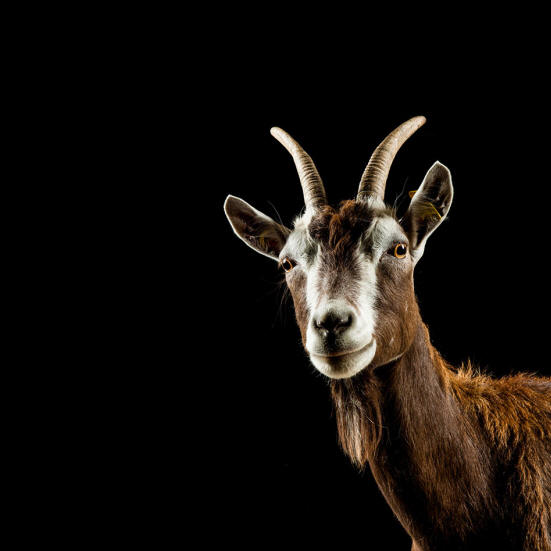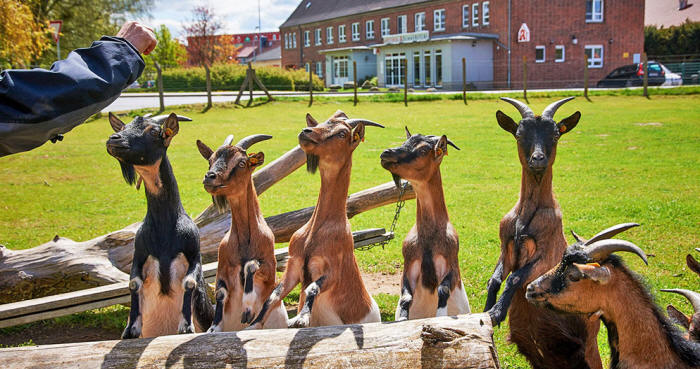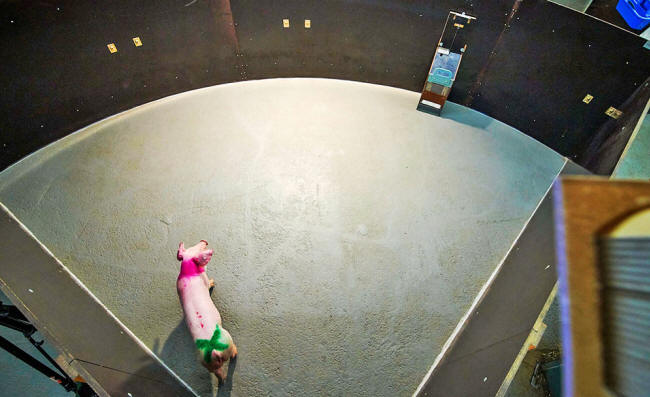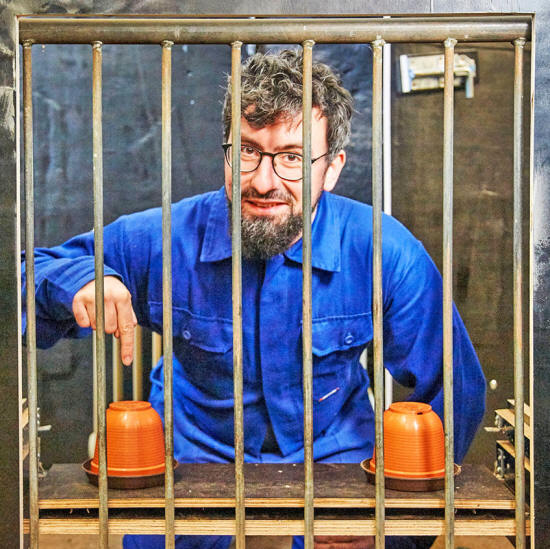|
by
David Grimm
PDF
Getty
Images surprising complexity in the minds of goats, pigs, and other livestock...
You'd never mistake a goat for a dog, but on an unseasonably warm afternoon in early September, I almost do. I'm in a red-brick barn in northern Germany, trying to keep my sanity amid some of the most unholy noises I've ever heard.
Sixty Nigerian dwarf goats are taking turns crashing their horns against wooden stalls while unleashing a cacophony of bleats, groans, and retching wails that make it nearly impossible to hold a conversation.
Then, amid the chaos, something remarkable happens.
One of the animals raises
her head over her enclosure and gazes pensively at me, her widely
spaced eyes and odd, rectangular pupils seeking to make contact -
and perhaps even connection.
On a campus that looks
like a cross between a farm and a small research institute - with
low-rise buildings nestled among pastures, stables, and the
occasional dung pile - scientists are probing the mental and
emotional lives of animals we've lived with for thousands of years,
yet, from a cognitive perspective, know almost nothing about.
Over the past decade, researchers at FBN and elsewhere have shown that pigs show signs of empathy, goats rival dogs in some tests of social intelligence, and, in one of the field's, um, splashiest recent finds, cows can be potty trained, suggesting a self-awareness behind the blank stares and cud chewing that has shocked even some experts.
...says Christopher Krupenye, a Johns Hopkins University psychologist who explores cognition in humans and more traditional animal models such as chimpanzees and dogs.
The field faces challenges, however, and not just because of rambunctious goats.
Farm animals can be huge, many are hard to train, and traditional funders and high-profile journals have generally spurned such studies.
But as scientists push past these obstacles, they are gaining insights not only into the minds of livestock, but into the evolution of our own cognition as well.
What they learn could even change the way we house and treat these creatures.
In an enclosed L-shaped barn at FBN that houses more than 700 pigs, I'm in for a bit of hazing.
Or at least that's what it feels like at first...
Before entering the main part of the building, my guides tell me to strip down to my underwear and don a baggy pair of blue overalls.
In truth, the researchers don't want visitors bringing in deadly diseases like African swine fever.
But the disrobing has other benefits:
In a small room, researchers are herding hulking hogs - just 6 months old but already 120 kilograms - one by one into a run with a treadmill.
Instead of a conventional treadmill's control panel, there's a grapefruit-size glowing blue button at snout height that the animals can press to run the machine for a few seconds.
Today, however, no one
seems very interested in working out.
Katharina Metzger and Annika Krause, the postdoc and technician, respectively, running the study, tell me I may be making the animals nervous.
Last week, they say, one
pushed the button seven times and kept coming back for more.
A couple of decades ago, work like this would have been laughed out of the barn.
There are an estimated 78 billion farm animals on Earth - a number that dwarfs monkeys, rodents, and humans combined - and we have lived with them longer than any other creature save dogs.
Yet in an era where
researchers are
modeling rat brains on computers
and showing that
our canine pals may be able to intuit our
thoughts, livestock remain a black box.
where scientists entice them to participate in cognition tests with crunchy pieces of dried pasta. Thomas Häntzschel/Nordlicht
Why waste your time if it's not going to improve milk or meat production, he recalls them asking.
Nawroth did.
Though he began his career researching decision-making in great apes, he switched to livestock in 2010.
Nawroth was hooked.
In a different room in the pig barn, Nawroth's colleagues are investigating whether pigs are sensitive to one another's feelings.
Ten 6-week-old piglets cower together in the corner of a gated pen spread with straw. Like the treadmill hogs, they don't seem to be fans of strangers.
The question is,
Ethologist Liza Moscovice is hoping to find out.
At an opening in the pen, she has placed a large box with a mesh window and a door. After a few minutes, the pigs begin to explore the new installation, congregating around a handle on the door.
None has been trained to open a box like this, but they are soon sniffing and biting the lever until a couple realize that they can snout it up to open the door. Several then rush inside and begin to nose around.
In recent experiments, the box becomes a trap.
The study is a test of empathy inspired by a 2020 incident on a wildlife preserve near Prague.
Several boars - the ancestors of modern pigs - gathered around a cage containing two younglings, until one figured out how to open it. At FBN, Moscovice and her colleagues have observed something similar in piglets.
In a study published this summer, the team showed that, 85% of the time, the animals freed a trapped companion within 20 minutes.
The liberators were more likely to open the box when a pig was trapped inside than when it was empty, ruling out mere curiosity.
Those that spent more time staring at their trapped companion were also more likely to help, especially if that companion squealed in distress, suggesting the helpers were sensitive to the "emotional state" of the boxed pigs.
Critics have argued that animals might help others simply to alleviate their own stress at seeing or hearing a trapped companion.
But saliva samples Moscovice collected did not show elevated levels of the stress hormone cortisol in the helper pigs, consistent with a more selfless reason for the assistance.
Elsewhere in the barn, behavioral biologist Sandra Düpjan has been replicating the famous "marshmallow test" with pigs.
For pigs, the prize isn't marshmallows but applesauce, an especially favored treat.
Studies in the early 1970s suggested children who pass the test tend to be more successful later in life (though those findings have been disputed).
Pigs aren't going to college, but the experiment may help probe why some animals seek out more productive feeding grounds instead of settling for closer, poorer foraging.
In an open arena, pigs learn that one side always contains a box with a treat, whereas the other features a "punishment." If they decide to explore a box in between, scientists interpret that as a sign of optimism. Thomas Häntzschel/Nordlicht
In an open arena, the animals learn that one side always contains a box with a treat (again, the applesauce), whereas the other always features a "punishment." (The applesauce is inaccessible, and the researchers wave a plastic bag over the pigs, which they apparently hate.)
The scientists then place a box in the middle of the arena.
Cows, too, show signs of optimism and pessimism, other researchers have shown.
And like pigs, they may be capable of much more.
A squat yellow building about 1 kilometer north of the pig facility doesn't look like much, but it's home to one of the most headline-grabbing findings in farm animal research.
Two years ago, scientists potty trained cows here, teaching the animals to hold their bladder as they navigated a metal-gated hallway to a patch of artificial turf.
That may not seem like a big deal to us, but it was startling in creatures that seem to have no control over their excretions.
Not only did the cattle learn to "hold it" faster than many children do, their very ability to sense that they had to go countered the conventional wisdom that they lack "interoceptive awareness" - the capacity to think about what's going on in their own bodies, which in humans has been linked to happiness, love, and even life satisfaction.
Langbein's new work could cement this idea.
Next door, he shows me around a (blessedly) open-air stable, where four groups of dairy cows munch hay in separate quarters.
It all seems pretty complicated, but the goal here is simple.
On a real farm, she explains, farmers move dairy cows around multiple times a year, disrupting their social groups.
Are they also breaking up besties...?
These are not dumb creatures. They have a rich emotional life and personality. Jan Langbein Research Institute for Farm Animal Biology
After identifying each cow's ostensible best friend and worst enemy, Pahl brings the pairs into an open arena.
In a recent trial, "enemy" cows began head butting. But when one was placed with her friend, the two began grooming each other and following each other around.
As part of the study, which is still in its early stages, Pahl is also collecting heart rate and hormone level data to see how being separated from the group affects a cow's stress levels, and whether pairing it with a preferred companion can help.
He's not just speaking academically.
Langbein trained as a cattle breeder 40 years ago, and he's especially sensitive to the housing conditions on modern dairy farms, where animals are often tied up for long stretches or confined to tight pens.
But convincing farmers to change their ways is going to take more than a few scientific publications, Langbein says.
Already, he's starting to see changes.
Nawroth likes to describe himself as the man who stares at goats.
He's referencing the 2009 George Clooney movie based on a Jon Ronson book about the U.S. Army's attempts to harness psychic energy to kill the animals by glaring intently at them. (The efforts, shockingly, weren't successful.)
Nawroth's own studies are more grounded.
After abandoning his early work with pigs because he found the animals too hard to train, he switched to goats, which seemed just as interested in him as he was in them.
Christian Nawroth focuses on the cognitive abilities of goats. This test gauges whether the animals can understand the human pointing gesture - a sign of advanced social cognition. Thomas Häntzschel/Nordlicht
It's the sense of connection I experienced myself, and it has driven much of Nawroth's research.
In early work, he explored how goats measure up to dogs in a battery of cognitive tests. In an experiment known as the "impossible task," dogs confronted with a food bowl they can't access turn to humans for help,
But Nawroth showed that goats did the same, the first time the experiment had been tried with a food animal.
(Speaking of which, yes FBN has a slaughterhouse, and yes Nawroth has partaken in its spoils. This may be the only field of research where scientists eat their subjects when the study is over.)
Further experiments showed that goats, like dogs,
That's the advantage of studying livestock, he says.
Because farm animals encompass so many different species that are so far apart on the tree of life, they allow scientists to test just how widespread certain cognitive abilities are.
And because humans may have domesticated themselves when they began living in close-knit groups, such studies could even provide insight into the evolution of our own minds.
The studies on livestock, Krupenye says, are providing,
Now, Nawroth is pushing his goat research even further.
In a yard behind FBN's goat barn, Nawroth shows me a "fake apple tree." A tall metal pole juts out of the grass with another one balanced across the top.
The resulting seesaw holds a brick on one end and a birdfeeder-like container on the other.
The idea is to explore in a far more controlled environment a phenomenon that's been observed in the wild:
The behavior might sound like altruism, and that's what Nawroth hopes to test.
When a goat jumps on the platform, the birdfeeder (filled with dried penne pasta, which the animals munch like potato chips) lowers into a fenced-off area of the yard. The goat on the platform can't reach it, but a nearby goat can.
And in some cases, the platform goat lowers the food without any attempt to get it herself; she seemingly wants to help her companion reach it.
Nawroth, says it's too soon to say whether the animals are exhibiting altruism.
But Krupenye says any insight into the behavior will help scientists understand whether altruism truly exists in the animal kingdom - a subject of debate - and, if so, how it works.
Meanwhile, inside the barn, a goat is playing with an oversize iPad. Or at least that's what it looks like...
The animal is poking her head through an aperture in her enclosure, nosing a thin computer monitor that's displaying a livestock version of the "which one doesn't belong?" game.
Four pictures of goat faces flash on the screen, one slightly different from the rest.
When she nuzzles the correct one, which she always seems to do, a tube squirts water into her bowl. (The game is harder than it sounds. The images are nearly identical, and when I try it myself, I'm quite relieved when I get a squirt.)
The setup can test memory, too. In other experiments, the animals have learned the order of 28 symbols, and correctly recalled it weeks later - a performance comparable to that of primates and dolphins.
Nawroth finds it easy to work with goats:
But farm animals can still be challenging to study.
The sheer weight of cows and pigs makes them dangerous, and most livestock are used to living in herds; they can become uncooperative when separated from their group.
Elodie Briefer, an ethologist at the University of Copenhagen, says it can take up to a month for sheep to participate in her studies of emotion.
When the results do come, big journals often don't take notice.
They go to the dogs - literally.
What's worse, others say, most money for livestock research still goes to studies aimed at improving milk or meat yields, not to figuring out how these creatures think.
All of this may be keeping young scientists away, says Rebecca Nordquist, a biological psychologist at Utrecht University who explores cognition in pigs and chickens.
There are only about a half-dozen labs researching livestock cognition worldwide, and no conferences dedicated exclusively to the topic.
She also worries that many people may not want to know if the animals they think of as dinner turn out to have rich inner lives.
Still, Nawroth is optimistic.
He's spearheading a major initiative called ManyGoats that will connect dozens of researchers across the globe to share data, increasing sample sizes and bringing more rigor to livestock studies.
Jean-Loup Rault, head of the Institute of Animal Welfare Science at the University of Veterinary Medicine Vienna, is starting to see interest from researchers who used to scoff at farm animal studies.
When he presented some of his early livestock cognition findings in 2010 at the Society for Neuroscience conference - which typically attracts tens of thousands of attendees - he was the only one with a pig poster.
Krupenye says the growing pains in the farm animal field remind him of dog cognition research, which had to fight for its own respect a couple of decades ago when it was still in its infancy.
At the very least, Nawroth hopes the work will give people new respect for animals that have been overlooked for so long.
Getting inside their minds will expand our own, he says.
|





